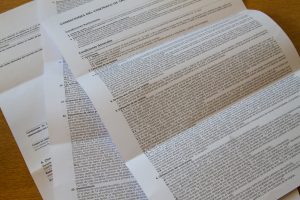The first Design to Read workshop was held at the British HCI Group conference “HCI2008 Culture, Creativity, Interaction” in Liverpool, UK, on 2nd September 2008. Read the workshop proposal.
Why people struggle to read

The content of the workshop reflected the interests of the people who participated. For example, nobody discussed the topics of writing for children, or writing for people who use screen readers to change electronic text into audio or Braille.
In the first part of the workshop, we described our recent work and interests. The audiences we work with include:
- people with visual impairments such as glaucoma
- people with cognitive impairments such as learning disabilities
- people with low literacy
- older people, who may have age-related impairments or may be unfamiliar with computers
We also encounter:
- reading difficulties caused by the context, such as not knowing the technical words (the jargon) in a text, or working in stressful conditions such as in a call centre
- reading difficulties caused by badly designed documents, such as the tiny patient information leaflets that are packaged with medicines.
One exciting new development that overcomes bad design of printed documents is to use a mobile phone as a magnifying glass. The software can increase the size of text, increase the contrast, remove background graphics, and change the image to greyscale.
What we learnt about design guidelines
One purpose of the workshop was to learn whether different design guidelines applied to different audiences. In other words, do the guidelines apply to all readers? Do the solutions for one audience cause problems for other audiences?
Sometimes, ‘solutions’ to a problem are not helpful. Consider large-print books for people who have problems with vision. One participant who has vision problems said that large-print books sometimes contain no navigation or location features, such as subheadings and bulleted lists (ordered lists), which can help people who have restricted vision. Text is sometimes aligned on the right side of the page (right justified), and that can make reading difficult.
We looked at pages on a government website that explains how to register to vote, and we saw how easy it is to write confusing text.
We found that most of the guidelines for one audience applied to all audiences. For example, many participants had guidelines such as ‘use short sentences’ and ‘use simple words’. One practitioner discussed Easy Read, which is a method of writing to help people with learning disabilities. Interestingly, most of the Easy Read guidelines for writing text are similar to the guidelines that technical communicators use when they create technical documents.
A few guidelines conflicted:
- One of the guidelines for readers who have glaucoma is that text should be in columns, like a newspaper. Columns do not work well with websites, because a reader must scroll up and down a page to read the text.
- One guideline for Easy Read is to use large text (16 point). Many readers who do not have special problems will be irritated by that large size.
The consensus was that design should be inclusive. As far as possible, people with impairments should be able to use the same text as people without impairments.
Next steps
We created a framework that relates the special problems of each audience to the logical and physical structure of a document. We intend to develop the matrix as a method of organising our thoughts and resources.
Participants in the workshop
Cathy Clarke, Technical author, UK
Jackon Feijo, Instituto Nokia de Tecnologia, Brazil
Joy Goodman-Deane, Cambridge University, UK
Katie Grant, Raincharm Communications Ltd., UK
Caroline Jarrett, Effortmark Ltd., UK
Suzette Keith, Middlesex University, UK
Neesha Kodagoda, Middlesex University, UK,
William Wong, Middlesex University, UK
Mike Unwalla, TechScribe, UK
Kathryn Summers, University of Baltimore, USA, joined us remotely for part of the workshop
